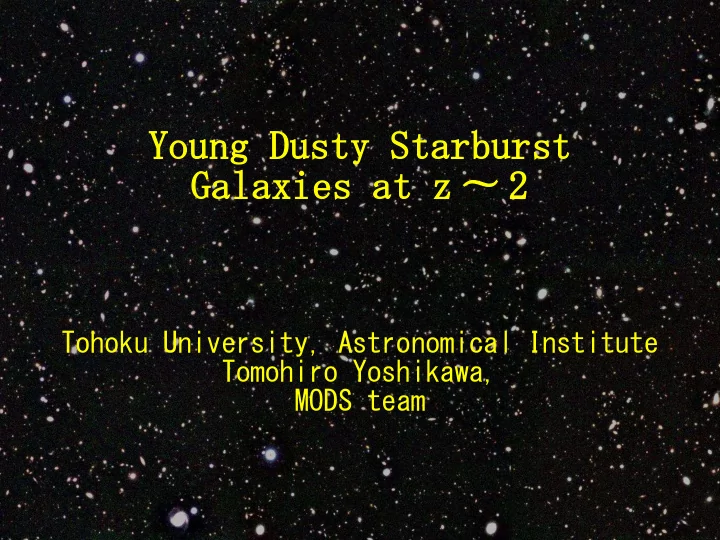

Young Dusty Starburst Galaxies at z 〜 2 Tohoku University, Astronomical Institute Tomohiro Yoshikawa, MODS team
Cosmic SFR Density Cosmic History of SFR Density cosmic SFR density has its peak at z 〜 2 and monotonically decays from z 〜 1 to the present universe. SFR Density (M ◎ yr -1 Mpc -3 ) -0.1 0.1- -0.01 0.01- (Caputi et al. 2007) What populations do contribute to the star formation at the star-forming epoch of the Universe? 2
Spectroscopic Observation of Galaxies at z 〜 2 Observation of Hα Emission Lines Star Formation Rate Indicator Spectroscopic Redshift difficult for optical instruments Sample Selection Star-Forming BzK designed to select z=1.4-2.5 MIPS+sBzK S 24 >80μJy: ULIRGs at z ~ 2 previous studies (e.g., BX/BM and DRGs) are biased by Present Samples (○) on BzK diagram attenuation/age Near-infrared spectrograph is suitable to study star-forming galaxies at z~2 → Subaru/MOIRCS ! 3
Data Star-Forming BzK galaxies K-selected star-forming galaxy at z~2 (MOIRCS Deep Survey field) with Ks < 23 (AB) S 24 > 80μJy: 18 39 galaxies S 24 < 80μJy: 21 in total X-ray galaxies (Alexander et al. 2003) are excluded. Observation HDF-N Subaru/MOIRCS MOS mode 4 masks (CDFN1-4) exposure time: 160-320 min HK500 grism + 0.8”slit: R~500 ※ serendipitous target of Akiyama et al. 4
Hα Emission Lines Hα Detection Rate obs. Hα rate S 24 >80μJy 26 15 58% S 24 <80μJy 13 8 62% total 39 23 59% Hα+[NII] Hα+[NII] 5
Hα Emission Lines Redshift Distribution sBzK galaxies lie at 1.4<z<2.5 The galaxies without emission line detection have smaller SFR? expected detection rate is much higher (>85%), if all samples have similar SFR. atmospheric Star Formation Rate Hα Luminosity absorption between H and K [erg/s] [L ◎ /yr] Extinction Corrected redshift 6
SFR and Stellar Mass Our Emission Line Galaxies only a weak correlation between SFR and M ★ L Hα [erg/s] A part of low mass galaxies have higher SFR Other Studies Daddi+ 2007 (sBzK, rest-UV) strong correlation other studies using Hα emission line also show week (shallower) correlation M ★ [M ◎ ] divide the samples into two groups with SSFR (■◇) 7
Young Dusty Starburst Galaxies Mass-Weighted Age and Extinction Large SSFR galaxies are young and dusty galaxies A part of BM/BX galaxies (Erb A V et al. 2006) are also young but less attenuated. mid-infrared selected samples choose the young and dusty galaxies? mass-weighted age ■◇: this work ●○: BM/BX (Erb et al. 2006) filled symbol: SSFR > 10 -8 yr -1 ○: S 24 >80μJy 8
Contribution to Cosmic SFR Density SFR Density Estimated from Hα Luminosity ■ SSFR > 10 -8 yr -1 : 0.105 M ◎ yr -1 Mpc -3 +0.020 -0.039 ◇ SSFR < 10 -8 yr -1 : 0.032 M ◎ yr -1 Mpc -3 +0.015 -0.006 SFR Density (M ◎ yr -1 Mpc -3 ) -0.1 0.1- -0.01 0.01- (Caputi et al. 2007) Low-mass young dusty galaxies significantly contribute to the cosmic SFR density 9
Summary We observed 39 sBzK galaxies and Hα emission lines are detected from 23 of them. Our emission line galaxies show only a weak correlation between stellar mass and star formation rate, owing to large specific SFR galaxies. Large specific SFR galaxies are young and dusty starburst galaxies with bright 24μm flux. Low-mass young dusty galaxies would significantly contribute to the cosmic SFR density at z ~ 2 10
Recommend
More recommend